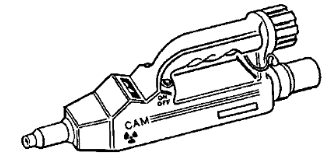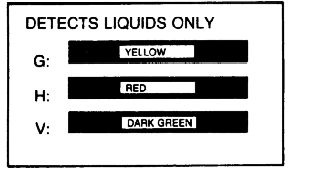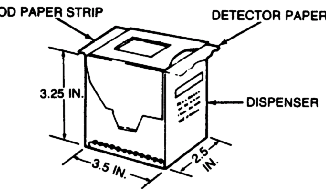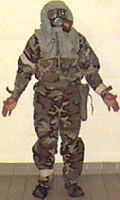
This TAB provides a listing of acronyms found in this report. Additionally, the Glossary section provides definitions for selected technical terms which are not found in common usage.
Acronyms |
| 2d MARDIV.....................................................................................................................................2d Marine Division |
| CAM...........................................................................................................................................chemical agent monitor |
| CBDCOM...................................................................................................Chemical and Biological Defense Command |
| CENTCOM.......................................................................................................................................Central Command |
| CRDEC................................................................Chemical Research, Engineering and Development Engineering Center |
| CW......................................................................................................................................................chemical warfare |
| CWA..........................................................................................................................................chemical warfare agent |
| EOD..................................................................................................................................Explosive Ordnance Disposal |
| ERDEC...............................................................................Engineering, Research and Development Engineering Center |
| G-2...............................................................................................................................................................Intelligence |
| G-3...............................................................................................................................................................Operations |
| HE............................................................................................................................................................high explosive |
| JCMEC........................................................................................................Joint Captured Material Exploitation Center |
| MARCENT............................................................................................................................Marine Central Command |
| MEF....................................................................................................................................Marine Expeditionary Force |
| MIB.....................................................................................................................................military intelligence battalion |
| MOPP.......................................................................................................................mission oriented protective posture |
| NBC.................................................................................................................................Nuclear, Biological, Chemical |
| NCO.......................................................................................................................................non-commissioned officer |
| NGIC......................................................................................................................National Ground Intelligence Center |
| NIST.......................................................................................................National Institute of Standards and Technology |
| SBCCOM.....................................................................................................Soldier Biological and Chemical Command |
| SME..............................................................................................................................................subject matter expert |
| SSM........................................................................................................................................surface-to-surface missile |
| TEU...............................................................................................................................................Technical Escort Unit |
| UNSCOM................................................................................................................................UN Special Commission |
Chemical Agent Monitor (CAM): The CAM is a hand-held, post-attack device used to monitor buildings, equipment, and personnel for contamination. The CAM is designed to detect chemical warfare agent vapors in two modes - G and H. While in G mode, the CAM can detect nerve agents. Switching to the H mode allows the CAM to detect mustard agents. The CAM draws in air, then samples it by sensing molecular ions of specific mobility (time of flight), and uses timing and microprocessor techniques to reject interference. The CAM uses a graphic bar to display the relative concentration of agent present.

False responses/interferents: The CAM may give false readings when used in enclosed spaces or when sampling near strong vapor sources (e.g., in dense smoke). Some vapors known to give false readings are aromatic vapors (perfumes, food flavorings, some after shaves, peppermints, cough lozenges, and menthol cigarettes when vapors are exhaled directly into the nozzle), cleaning compounds (disinfectants, methyl salicylate, menthol, etc.), smokes and fumes (exhaust from some rocket motors, fumes from some munitions), and some wood preservative treatments (polychlorinated biphenyls) when in an enclosed space. The operator should experiment in his environment to determine what common items will cause his CAM to respond.[126]
Fox NBC Reconnaissance Vehicle: The Fox NBC reconnaissance vehicle is a six-wheeled light armored vehicle. The Fox is capable of detecting all known chemical warfare agents. Its primary onboard liquid chemical warfare agent detection device is the MM-1 Mobile Mass Spectrometer. The MM-1 uses mass spectrometry to detect and identify any known chemical warfare agent that may be present. Simply, the MM-1 breaks agent molecules into smaller charged pieces called ions. The number and mass of the chemical warfare agent ions comprise the mass spectrum, providing a unique signature for each chemical substance. The Fox matches the sample spectrum against key ions of chemical substances. If a match is found, the MM-1 alerts the Fox crew to the possible presence of a chemical warfare agent. The MM-1 performs first a quick search for chemical warfare agents and then can later perform a more detailed spectrum analysis to rule out other chemicals with similar ion patterns.[127][128]
M256 Series Chemical Warfare Agent Detector Kit: The M256 kit is a portable, expendable item capable of detecting and identifying hazardous concentrations of chemical warfare agent. It is designed to detect blister, blood, and nerve agents. In the field, this kit was called simply the M256. The M256 kit is used after a chemical warfare agent warning as a confirmation of the presence of chemical warfare agents, and to determine when it is safe to unmask. The M256A1 kit has replaced the M256 kit. The only difference between the two kits is that the M256A1 kit will detect lower levels of nerve agent. This improvement was accomplished by using an eel enzyme for the nerve test in the M256A1 kit in place of the horse enzyme used in the M256 kit. Both the M256 kit and the M256A1 kit were used during the Gulf War.[129]
False responses/interferents: Some smokes, high temperatures, and petroleum products may cause false readings. Results may be inaccurate where sampling is done in smoke from burning debris.[130]
M8 Paper, Chemical Warfare Agent Detector VGH, ABC-M8
The M8 paper is used to detect the presence of liquid V, G, or H chemical warfare agents. For ease of use, M-8 paper is issued in a book of 25 sheets of chemically-treated, dye-impregnated paper, perforated for easy removal and a color comparison bar chart printed on the inside front cover of the book used for color comparison with chemical warfare agent reaction on the detector paper. M8 paper is widely distributed on the battlefield. Each soldier has a booklet in his protective mask carrier. It is also found in the carrying case for the M256A1 kit and in the M18A2 chemical warfare agent detection kit. M8 paper is used any time the soldier suspects liquid contamination is present. The paper must touch the liquid chemical warfare agent. It does not detect vapors. It is best suited for use on non-porous materials. Since M8 paper will also change color from many interferents, it is unreliable to check for completeness of decontamination. M8 paper is never used as a sole basis for agent identification. It must always be verified with more reliable means of identification (e.g., M256A1 kit). Also, soldiers have some difficulty identifying the color change at night and differentiating it from wet paper.

False responses/interferents: M8 paper responds to some common battlefield interferents. Among them are certain cleaning solvents (ammonia), "Break Free" (a weapons cleaner and lubricant), high temperatures, and some petroleum products.[131]
M9 chemical warfare agent detector paper is used to detect presence of liquid chemical warfare agents. Issued in a roll two inches wide and 30 feet long contained in a cardboard dispenser with a cutter edge. The detector paper is gray-green and has an adhesive back protected by a paper strip until dispensed from the roll. A reusable plastic storage bag is included for storing the dispenser after removal from the shipping bag. Battlefield uses include, attaching M9 paper to vehicles, chemical protective clothing and other mission essential equipment. When a liquid chemical warfare agent comes into contact with the paper, the dye in the paper reacts with the chemical warfare agent to form pink, red, red-brown, or red-purple spots or streaks.

False responses/interferents: The M9 paper may give false positive readings when exposed to temperatures above 1250F or below 320F, scuffing, grease, gasoline, oil, defoliants, and insecticides. M9 paper will not detect chemical agent vapors.[132]
MOPP: Mission-Oriented Protective Posture: MOPP represents a state of protection against chemical warfare agents. A flexible system, MOPP incorporates the wearing of individual protective equipment, with first aid treatments and decontamination kits to provide maximum NBC protection for the individual with the lowest risk possible to accomplish the mission. The wearing of MOPP gear provides soldiers protection against all known chemical warfare agents, live biological agents, and toxins. MOPP gear consists of the following items:
A person wearing MOPP gear can neither work for very long nor very fast. They may also suffer mental distress as a result of feeling closed in and can suffer from heat stress and heat exhaustion when working in warm temperatures and at high work rates. The MOPP concept arose from the need to balance individual protection with the threat, temperature, and urgency of the mission.[133] During the Gulf War, commanders could raise or lower the amount of protection through five levels of MOPP. In addition, commanders under certain situations could exercise a mask-only option.
(Picture depicts doctrine in effect during the gulf war)
 |
 |
 |
 |
 |
| MOPP-0 | MOPP-1 | MOPP-2 | MOPP-3 | MOPP-4 |
MOPP Level Zero: Individuals must carry their protective mask with them at all times. Their remaining MOPP gear must be readily available (e.g., within the work area, fighting position, living space, etc.).
MOPP Level One: Individuals wear their overgarment. They must carry the rest of their MOPP gear.
MOPP Level Two: Individuals wear their overgarment and overboots and carry the mask with hood and gloves.
MOPP Level Three: Individuals wear their overgarment, overboots, and mask with hood. They carry the gloves.
MOPP Level Four: Individuals wear all their MOPP gear.[134]
Nerve Agents: Nerve agents are organophosphate ester derivatives of phosphoric acid. They are generally divided into the G-agents, which in the unmodified state are volatile (easily vaporized), and the V-agents, which tend to be more persistent. Some G-agents are capable of being thickened with various substances to increase the persistence and penetration of exposed skin. The principal nerve agents are tabun (GA), sarin (GB), soman (GD), and VX. The G-agents are organophosphates containing either fluorine or cyanide. In pure form they are colorless liquids. Their solubility in water ranges from complete solubility for GB to almost total insolubility for GD. They have a weakly fruity odor but in field concentrations are odorless. The V-agents are organophosphorous compounds containing sulfur. They are oily liquids with high boiling points; they do not vaporize easily and are consequently highly persistent. They are therefore primarily contact hazards and are exceptionally toxic. Nevertheless, the limited amount of vapor they do produce is enough to be a hazard if inhaled. They do not mix with or spread through water, and any chemical reaction with water is minimal. V-agents affect the body in essentially the same manner as G-agents.
The nerve agents are not really "gases;" technically, they are all viscous liquids and are spread in the form of liquid drops. Since G-agents vaporize easily, they become rapidly lethal in an airborne state. GB, for instance, vaporizes so easily that small droplets sprayed from a plane or released from a shell exploding in the air may never reach the ground. Consequently, GB is largely a vapor hazard. At the other extreme, agent VX hardly vaporizes at all - making it mainly a liquid contact hazard. Physical harm can occur from the spray falling on one’s skin or clothes and from touching surfaces on which the spray has fallen. GD is also mainly a vapor hazard, while GA contaminates surfaces for a sufficiently long time to be a contact hazard. Thickeners added to GD increase persistence in the field. The thickened agents form large droplets - thereby concentrating the agent reaching the ground and making the contact hazard greater. The ability of GB and GA to mix with water means that water can wash these agents off surfaces, that these agents can easily contaminate water sources, and that they will not penetrate skin as readily as the more fat-soluble agents VX and GD. G-agents spread rapidly on surfaces (like skin); VX spreads less rapidly, and the thickened agents very slowly. The moist surfaces in the lungs absorb all the agents very well.
Both G-agents and V-agents have the same physiological action on humans. They are potent inhibitors of the enzyme acetylcholinesterase (AChE), which is required for the proper function of many nerves and muscles in nearly every multicellular animal. Normally, AChE prevents the accumulation of acetylcholine after its release in the nervous system. Acetylcholine plays a vital role in stimulating voluntary muscles and nerve endings of the autonomic nervous system and many structures within the central nervous system. Thus, nerve agents that are cholinesterase inhibitors permit acetylcholine to accumulate at those sites, mimicking the effects of a massive acetylcholine release, and striking particularly skeletal muscles, parasympathetic end organs, and the central nervous system. Individuals poisoned by nerve agents may display the following symptoms:[135]
The number and severity of symptoms depend on the quantity and path of entry into the body. When the agent is inhaled, the pupils of the eyes often pinpoint, reducing the amount of incoming light and dimming vision. If exposure is through the skin or by ingestion, however, the pupils may be normal or only slightly to moderately reduced in size. In this event, correct diagnosis depends on recognizing the other symptoms of nerve agent poisoning. Exposure through the eyes produces a very rapid onset of symptoms (usually in less than 2 to 3 minutes). Respiratory exposure usually brings on symptoms in 2 to 5 minutes. Lethal doses kill in less than 15 minutes. Liquid in the eye kills nearly as rapidly as respiratory exposure. Symptoms appear much more slowly from skin absorption. Skin absorption great enough to cause death may take one to two hours to become fatal. Very small skin dosages sometimes cause local sweating and tremors but little other effects. Nerve agents are cumulative poisons. Repeated exposure to low concentrations, if not too far apart, will produce symptoms. The treatment of nerve agent poisoning includes the use of the nerve agent antidote. Certain rapidly "aging" agents, like GD, may resist treatment if it is not prompt. Therefore, an antidote enhancer, pyridostigmine bromide (PB), is available to US forces in active theaters of operation. PB pretreatment increases the victim’s survivability when the antidote is used after exposure to nerve agents.[136]
| First Page | Prev Page | Next Page |